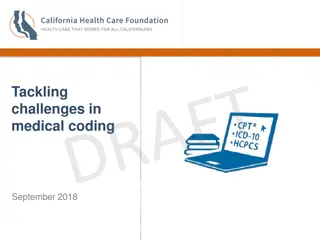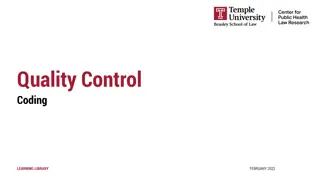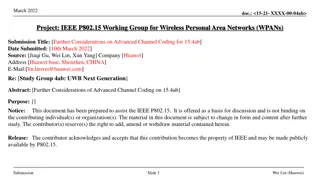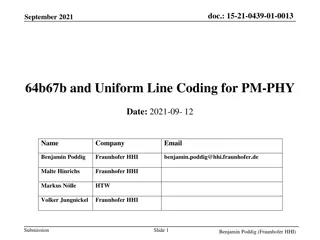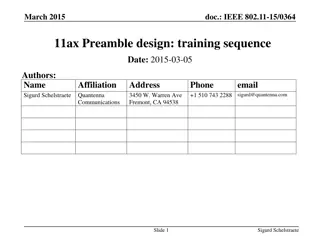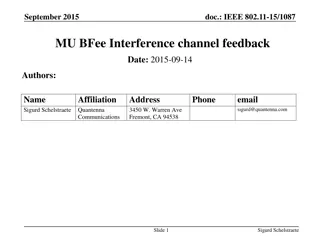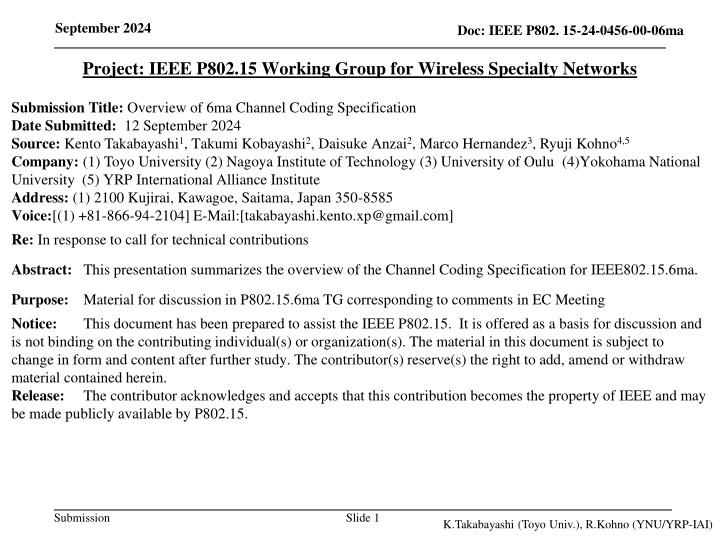
Insight into 6ma Channel Coding Specification
Delve into the Channel Coding Specification for IEEE802.15.6ma, addressing error correcting schemes, codes, and quality of service considerations for wireless specialty networks. The document outlines the selection of codes for error correction and interference mitigation in the 6ma protocol.
Download Presentation

Please find below an Image/Link to download the presentation.
The content on the website is provided AS IS for your information and personal use only. It may not be sold, licensed, or shared on other websites without obtaining consent from the author. If you encounter any issues during the download, it is possible that the publisher has removed the file from their server.
You are allowed to download the files provided on this website for personal or commercial use, subject to the condition that they are used lawfully. All files are the property of their respective owners.
The content on the website is provided AS IS for your information and personal use only. It may not be sold, licensed, or shared on other websites without obtaining consent from the author.
E N D
Presentation Transcript
September 2024 Doc: IEEE P802. 15-24-0456-00-06ma Project: IEEE P802.15 Working Group for Wireless Specialty Networks Submission Title: Overview of 6ma Channel Coding Specification Date Submitted: 12 September 2024 Source: Kento Takabayashi1, Takumi Kobayashi2, Daisuke Anzai2, Marco Hernandez3, Ryuji Kohno4,5 Company: (1) Toyo University (2) Nagoya Institute of Technology (3) University of Oulu (4)Yokohama National University (5) YRP International Alliance Institute Address: (1) 2100 Kujirai, Kawagoe, Saitama, Japan 350-8585 Voice:[(1) +81-866-94-2104] E-Mail:[takabayashi.kento.xp@gmail.com] Re: In response to call for technical contributions Abstract: This presentation summarizes the overview of the Channel Coding Specification for IEEE802.15.6ma. Purpose: Notice: is not binding on the contributing individual(s) or organization(s). The material in this document is subject to change in form and content after further study. The contributor(s) reserve(s) the right to add, amend or withdraw material contained herein. Release: The contributor acknowledges and accepts that this contribution becomes the property of IEEE and may be made publicly available by P802.15. Material for discussion in P802.15.6ma TG corresponding to comments in EC Meeting This document has been prepared to assist the IEEE P802.15. It is offered as a basis for discussion and Submission Slide 1 K.Takabayashi (Toyo Univ.), R.Kohno (YNU/YRP-IAI)
Doc: IEEE P802. 15-24-0456-00-06ma September 2024 Overview of 6ma Channel Coding Specification September 2024, Hybrid Session, Hilton - Waikoloa, HI Kento Takabayashi(1), Takumi Kobayashi(2), Daisuke Anzai(2), Marco Hernandez(3), Ryuji Kohno(4,5) (1) Toyo University (2) Nagoya Institute of Technology (3) University of Oulu (4)Yokohama National University (5) YRP International Alliance Institute Submission Slide 2 K.Takabayashi (Toyo Univ.), R.Kohno (YNU/YRP-IAI)
Doc: IEEE P802. 15-24-0456-00-06ma September 2024 Table of error correcting scheme [1] Submission Slide 3 K.Takabayashi (Toyo Univ.), R.Kohno (YNU/YRP-IAI)
Doc: IEEE P802. 15-24-0456-00-06ma September 2024 Forward error correcting codes in TG6ma [2] User priority Inner code Outer code HARQ 0 15.4ab LDPC or BCC (R=1/2) - 1 15.4ab LDPC or BCC (R=1/2) - 2 15.4ab LDPC or BCC (R=1/2) - 3 15.4ab LDPC or BCC (R=1/2) - 4 15.4ab LDPC (R=1/2) (54, 46) shortened RS code - 5 15.4ab LDPC (R=1/2) (54, 38) shortened RS code - 6 15.4ab LDPC (R=1/2) (54, 28) shortened RS code - 7 15.4ab LDPC (R=1/2) (54, 14) shortened RS code - As an outer code, shortened Reed-Solomon (RS) codes with N=54 (original code length N=63) will be selected to correct burst errors due to interference from other WBANs The coding rates are changed according to each QoS As an inner code, 15.4ab LDPC (K=324, 648, 972, R=1/2) or BCC will be selected for the coexistence of 15.6ma and 15.4ab Submission Slide 4 K.Takabayashi (Toyo Univ.), R.Kohno (YNU/YRP-IAI)
Doc: IEEE P802. 15-24-0456-00-06ma September 2024 Coexistence environment level Coexistence environment class 0 1 [1a] 2 [1b] 3 4 [2a] 5 [2b] 6 [2c] Environment 6ma BAN only Multiple 6ma BANs 1a Multiple 15.6 & 6ma BANs Multiple 6ma BANs & non-UWB systems (Wi-Fi & Unlicensed 3GPP) Multiple 6ma BANs & 802.15 UWB systems Multiple 6ma BANs, non-802.15 UWB systems (ETSI UWB systems) Multiple 6ma BANs & 802.15 UWB & non-802.15 UWB systems (ETSI UWB) Multiple 6ma BANs & non-UWB systems (Wi-Fi & Unlicensed 3GPP) & 802.15 UWB & non-802.15 UWB systems (ETSI UWB) 7 A hybrid ARQ (HARQ) shall be utilized at the environments which several systems coexist in 15.6ma considers the half-rate BCC and LDPC as an error correcting code A HARQ scheme using those FEC is introduced Submission Slide 5 K.Takabayashi (Toyo Univ.), R.Kohno (YNU/YRP-IAI)
Doc: IEEE P802. 15-24-0456-00-06ma September 2024 Hybrid ARQ mechanism (BCC case) [3] 1. Firstly, the information bit sequence ? is encoded by BCC (K=7, R=1/2) 2. An encoded codeword is punctured via the punctured matrices as shown in the previous slide, and codeword 1 and 1 are generated Submission Slide 6 K.Takabayashi (Toyo Univ.), R.Kohno (YNU/YRP-IAI)
Doc: IEEE P802. 15-24-0456-00-06ma September 2024 Hybrid ARQ mechanism (BCC case) 6. If bit errors are detected after decoding the reconstructed codeword , a receiver buffers the reconstructed codeword 1, and a transmitter re-sends the codeword 1 to a receiver 7. At the receiver, transmitted codeword 1 is combined with the buffered reconstructed codeword 1, and a reconstructed codeword 2 (R 1/3) is generated 8. After that, codeword 1 and 1 are transmitted alternately, and the receiver reconstructs and decodes low-rate error correcting codes Submission Slide 7 K.Takabayashi (Toyo Univ.), R.Kohno (YNU/YRP-IAI)
Doc: IEEE P802. 15-24-0456-00-06ma September 2024 Hybrid ARQ mechanism (BCC case) ?: Counter of the number of transmissions, initially ? = 0 ?: The maximum number of transmissions, user defined ??: Coding rate at the ?th transmission ?1decreases as follows: 8/9 1/2 1/3 1/4 1/5 The punctured matrices are as follows: Codeword 1 1 0 0 1 1 0 0 1 1 0 0 1 1 1 0 1 Codeword 1 1 1 1 0 0 1 1 0 0 1 1 0 0 1 1 0 Submission Slide 8 K.Takabayashi (Toyo Univ.), R.Kohno (YNU/YRP-IAI)
Doc: IEEE P802. 15-24-0456-00-06ma September 2024 Hybrid ARQ mechanism (LDPC case) ?: Counter of the number of transmissions, initially ? = 0 ?: The maximum number of transmissions, user defined In LDPC case, the mechanism is the same as the HARQ defined in 15.6 Std.-2012 Submission Slide 9 K.Takabayashi (Toyo Univ.), R.Kohno (YNU/YRP-IAI)
Doc: IEEE P802. 15-24-0456-00-06ma September 2024 Results with Interleaving w/o Interleaving Packet error ratio as a function of SNR in the case of bit erasure channel, with and without inter-leaver [2] Submission Slide 10 K.Takabayashi (Toyo Univ.), R.Kohno (YNU/YRP-IAI)
Doc: IEEE P802. 15-24-0456-00-06ma September 2024 Results Packet error ratio as a function of ??/?0in the case of BCC with HARQ, ????= 0,1,3 [3] Submission Slide 11 K.Takabayashi (Toyo Univ.), R.Kohno (YNU/YRP-IAI)
Doc: IEEE P802. 15-24-0456-00-06ma September 2024 Results Packet error ratio as a function of ??/?0in the case of LDPC with HARQ, ????= 0,1,3 [3] Submission Slide 12 K.Takabayashi (Toyo Univ.), R.Kohno (YNU/YRP-IAI)
Doc: IEEE P802. 15-24-0456-00-06ma September 2024 Conclusion In low priority QoS cases (0~3), only a single error correcting code are applied In high priority QoS cases (4~7), an outer and an inner error correcting codes are concatenated HARQ schemes utilizing BCC and LDPC are utilized at the environments which several systems coexist in (especially class 7) Previous evaluations confirmed the effectiveness of the above error correcting schemes As an additional option, application of Super Orthogonal Convolutional Codes (SOCC) is also considered [4] Submission Slide 13 K.Takabayashi (Toyo Univ.), R.Kohno (YNU/YRP-IAI)
Doc: IEEE P802. 15-24-0456-00-06ma September 2024 Reference [1] Ryuji Kohno, TG6ma Coexistence Assurance Document, IEEE P802.15- 24-0348-02-06ma [2] Daisuke Anzai, et al., Performance Evaluation of Channel Coding with Interleaver Based on TG6ma Channel Model for Some Classes of Coexistence, IEEE P802.15-24-0247-02-06ma [3] Kento Takabayashi, et al., Hybrid ARQ Scheme for High QoS Packets in High Class of Coexistence of IEEE 802.15.6ma, IEEE P802. 15-23-0576-05- 06ma [4] Kento Takabayashi, et al., Evaluation of IEEE 802.15.6ma Ultra-wideband Physical Layer Utilizing Super Orthogonal Convolutional Code, IEEE P802. 15-22-0562-11-06ma Submission Slide 14 K.Takabayashi (Toyo Univ.), R.Kohno (YNU/YRP-IAI)
September 2024 Doc: IEEE P802. 15-24-0456-00-06ma Thank you for your attention ! ! ! Submission Slide 15 K.Takabayashi (Toyo Univ.), R.Kohno (YNU/YRP-IAI)
Doc: IEEE P802. 15-24-0456-00-06ma September 2024 SOCC Fig. SOCC encoder SOCC is a kind of orthogonal convolutional code of very low coding rate The encoder is composed of K length shift registers (constraint length) and a block orthogonal (Hadamard) encoder The coding rate is given by ?????= ?? ? The decoder uses the Viterbi algorithm ? Submission Slide 16 K.Takabayashi (Toyo Univ.), R.Kohno (YNU/YRP-IAI)
Doc: IEEE P802. 15-24-0456-00-06ma September 2024 Results Packet error ratio as a function of ??/?0in the case of 15.4ab BCC, LDPC, and SOCC with random inter-leaver, ??= 30% Submission Slide 17 K.Takabayashi (Toyo Univ.), R.Kohno (YNU/YRP-IAI)





